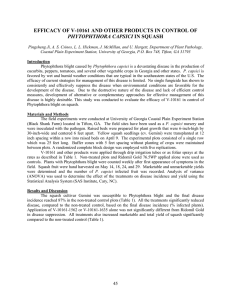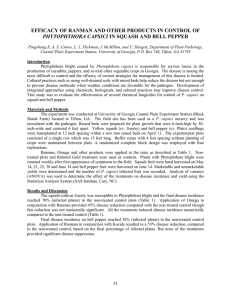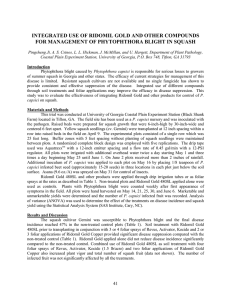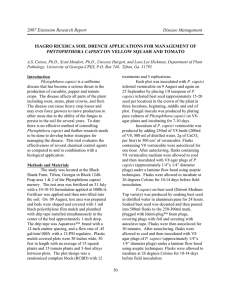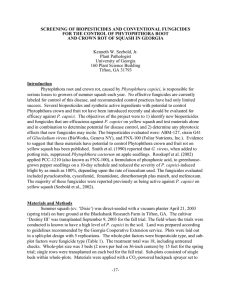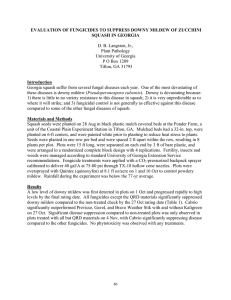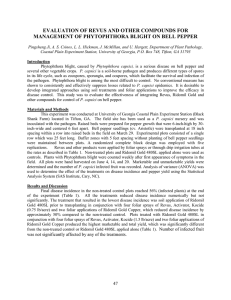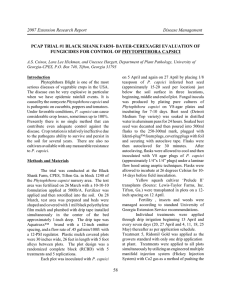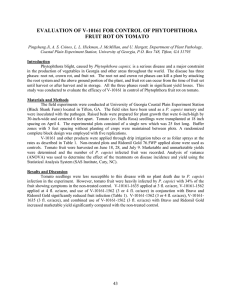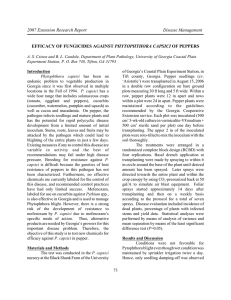MUSCODOR ALBUS PHYTOPHTHORA CAPSICI
advertisement
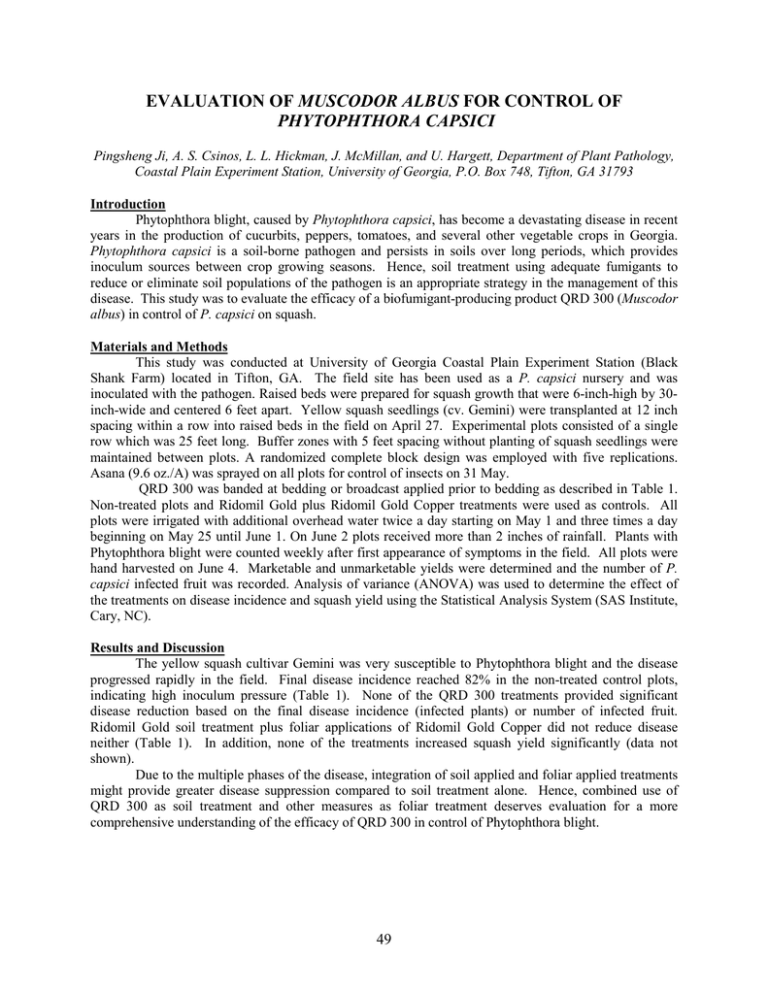
EVALUATION OF MUSCODOR ALBUS FOR CONTROL OF PHYTOPHTHORA CAPSICI Pingsheng Ji, A. S. Csinos, L. L. Hickman, J. McMillan, and U. Hargett, Department of Plant Pathology, Coastal Plain Experiment Station, University of Georgia, P.O. Box 748, Tifton, GA 31793 Introduction Phytophthora blight, caused by Phytophthora capsici, has become a devastating disease in recent years in the production of cucurbits, peppers, tomatoes, and several other vegetable crops in Georgia. Phytophthora capsici is a soil-borne pathogen and persists in soils over long periods, which provides inoculum sources between crop growing seasons. Hence, soil treatment using adequate fumigants to reduce or eliminate soil populations of the pathogen is an appropriate strategy in the management of this disease. This study was to evaluate the efficacy of a biofumigant-producing product QRD 300 (Muscodor albus) in control of P. capsici on squash. Materials and Methods This study was conducted at University of Georgia Coastal Plain Experiment Station (Black Shank Farm) located in Tifton, GA. The field site has been used as a P. capsici nursery and was inoculated with the pathogen. Raised beds were prepared for squash growth that were 6-inch-high by 30inch-wide and centered 6 feet apart. Yellow squash seedlings (cv. Gemini) were transplanted at 12 inch spacing within a row into raised beds in the field on April 27. Experimental plots consisted of a single row which was 25 feet long. Buffer zones with 5 feet spacing without planting of squash seedlings were maintained between plots. A randomized complete block design was employed with five replications. Asana (9.6 oz./A) was sprayed on all plots for control of insects on 31 May. QRD 300 was banded at bedding or broadcast applied prior to bedding as described in Table 1. Non-treated plots and Ridomil Gold plus Ridomil Gold Copper treatments were used as controls. All plots were irrigated with additional overhead water twice a day starting on May 1 and three times a day beginning on May 25 until June 1. On June 2 plots received more than 2 inches of rainfall. Plants with Phytophthora blight were counted weekly after first appearance of symptoms in the field. All plots were hand harvested on June 4. Marketable and unmarketable yields were determined and the number of P. capsici infected fruit was recorded. Analysis of variance (ANOVA) was used to determine the effect of the treatments on disease incidence and squash yield using the Statistical Analysis System (SAS Institute, Cary, NC). Results and Discussion The yellow squash cultivar Gemini was very susceptible to Phytophthora blight and the disease progressed rapidly in the field. Final disease incidence reached 82% in the non-treated control plots, indicating high inoculum pressure (Table 1). None of the QRD 300 treatments provided significant disease reduction based on the final disease incidence (infected plants) or number of infected fruit. Ridomil Gold soil treatment plus foliar applications of Ridomil Gold Copper did not reduce disease neither (Table 1). In addition, none of the treatments increased squash yield significantly (data not shown). Due to the multiple phases of the disease, integration of soil applied and foliar applied treatments might provide greater disease suppression compared to soil treatment alone. Hence, combined use of QRD 300 as soil treatment and other measures as foliar treatment deserves evaluation for a more comprehensive understanding of the efficacy of QRD 300 in control of Phytophthora blight. 49 Table 1. Efficacy of QRD 300 (Muscodor albus) in control of Phytophthora blight on squash Disease Infected Infected plant 1,2 fruit (%)1,3 Treatment and rate Application schedule Non-treated control ---- 6.8 ab 82.0 a QRD 300, 3.75 g/L soil Banded at bedding 3.6 ab 88.7 a QRD 300, 1.9 g/L soil Banded at bedding 4.4 ab 88.7 a QRD 300, 0.55 g/L soil Banded at bedding 7.0 ab 89.3 a QRD 300, 1.9 g/L soil Broadcast prior to bed 8.4 a 86.7 a Ridomil Gold, 2.0 pt/A At transplant 1.8 b 81.3 a Ridomil Gold Copper, 2.5 lb/A Four weekly applications beginning at flowering post plant 1 Data are means of five replications. Means within a column followed by the same letter are not significantly different (P = 0.05) according to Duncan’s multiple range test. 2 Number of P. capsici infected fruit each plot. 3 Final disease incidence. 50
